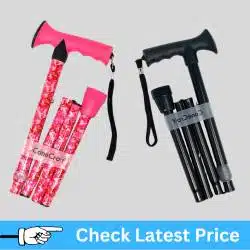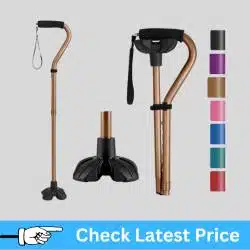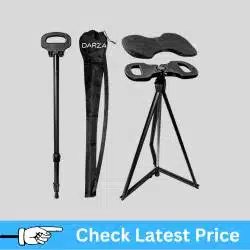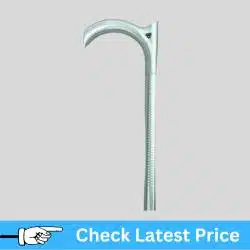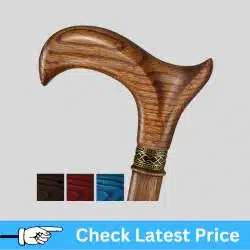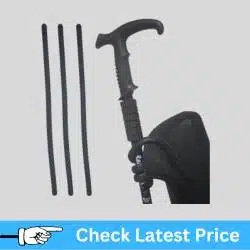by Ellen Blake
How do you choose the best walking canes and sticks for seniors? If you can convince your elderly loved ones to use them, that is. I get that people associate canes and walkers with weakness, aging, and dependency and that many older adults prefer not to go out at all than to go with a mobility aid. I’m guessing it’s possible I might feel the same way when I get to that point. However, walking canes and sticks are vital aids for seniors, enhancing stability, mobility, and independence. These assistive devices provide crucial support, significantly reducing the risk of falls and injuries. Not only will your loved one be able to go further for longer, but they also won’t need to depend on others to help them. Instead of limiting them, a walking cane or stick can help them stay active, allowing them to continue to engage in events and social activities they want to do.
With so many walking canes available that are created with different designs, available, and functions, the choices might seem overwhelming. The purpose of this article is to provide details about the options available to help you find the one that best works for you. We included a few examples that we like, but there are many others to choose from!
The Benefits of Walking Canes and Sticks for Seniors
So, what are the benefits of walking canes and sticks for seniors? For starters, they offer stability, reducing the risk of falls and providing essential support. In addition, they enhance mobility, aid in navigating uneven surfaces, and alleviate joint stress. Beyond physical benefits, these tools boost confidence, enabling individuals to maintain independence and an active lifestyle, while promoting overall well-being in their daily lives. There’s a reason canes are the most widely used mobility device, according to the National Center for Health Statistics. Some 4.8 million Americans rely on them.
Let’s look a little more closely at the specific benefits of canes.
Enhanced Mobility
Canes are like trusty sidekicks that make walking easier and more enjoyable for older adults, especially people who are elderly and facing physical challenges. They enhance mobility by lightening the load on joints, helping redistribute weight, and easing the strain on the legs. Picture them as reliable companions that lend a hand (or handle!) on bumpy paths, ensuring your loved ones navigate through life’s twists and turns with confidence. The customizable nature of canes, with adjustable height options, ensures a tailored fit for individual users. This adaptability is pivotal in optimizing the effectiveness of the cane, making it a personalized aid for improved mobility.
Increased Stability and Balance
Canes act as a reliable and adjustable support system, offering users the stability needed to move with confidence and maintain balance, especially when encountering challenges due to aging or mobility impairments. For example, the base of the cane provides good support and enhances stability, reducing the risk of tipping or swaying while walking. On slopes or stairs, canes assist in stability and balance by distributing the weight by providing an extra point of contact. Walking canes also offer tactile feedback to the user about the ground surface. This feedback helps individuals detect changes in terrain, such as uneven surfaces or obstacles, allowing them to adjust their movements accordingly and avoid potential hazards that might affect their balance. This feature is particularly helpful for those with vision problems. For individuals with weakness or pain in one leg, a cane used on the opposite side assists in weight-bearing. Finally, canes help individuals maintain an upright posture, essential for balance, and help users stand and walk more comfortably and aligned.
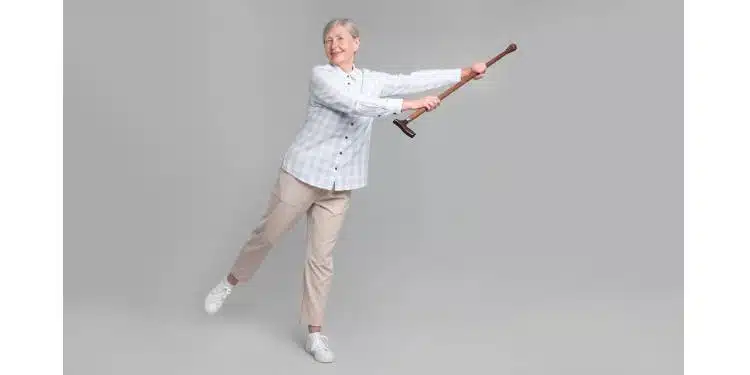
Injury Prevention
Walking canes and sticks are commonly for injury prevention. Here are details about several of the reasons these assistive devices can be beneficial:
Improved Balance
One of the primary reasons seniors are prone to falls and injuries is a decline in balance. That’s certainly a problem for me. Canes and walking sticks provide additional points of contact with the ground, enhancing stability and helping maintain our balance while walking.
Reduction of Weight-Bearing
Canes and walking sticks can help distribute weight away from an injured or weaker leg. This is particularly useful for those with injuries, arthritis, or joint pain, as it can relieve pressure on the affected limb and promote a more even weight distribution.
Assistance in Walking
A cane can help people with mobility issues or leg weakness walk more comfortably with less strain on their muscles and joints.
Energy Conservation
Walking canes can help conserve energy by providing support and stability. This is especially important for those with conditions that cause fatigue, such as heart or respiratory problems.
Joint Protection
People with arthritis or other joint-related conditions often find that using a cane or walking stick helps reduce the stress on their joints. By providing additional support, these devices can ease the strain on the knees, hips, and spine.
Posture Support
You can adjust canes to the user’s height, promoting proper posture while walking. Maintaining good posture is essential to prevent back pain and maintain overall musculoskeletal health.
Obstacle Navigation
We may encounter uneven surfaces or obstacles in our path, which can significantly increase our risk of falling. Canes and walking sticks can detect and navigate these obstacles, reducing the likelihood of accidents. A cane was an invaluable tool for my dad before he had his cataract surgery.

Independence and Confidence
Many of us fear falling as we age, which can lead to decreased activity and mobility. Walking canes act as a reliable support system, reducing the risk of falls and therefore promoting a more secure and confident gait. With greater confidence, we can engage in activities we (or our loved ones) might otherwise avoid. The key is to get past the negative connotations of using a cane; once you can do that, you will realize how much more independent you feel.
I spoke with Mary, age 72, whose doctor recommended getting a cane because her arthritis is so severe, he said her knees could go at any moment. She said she knew she needed assistance with her increasingly deteriorating balance, but until recently refused to use a cane. Eventually, she realized she no longer had a choice and finally purchased one. As I hear from many other new adopters of canes, she wished she decided to use one much earlier. Mary shared, “This cane makes me feel so stable and balanced that I’m not afraid to walk longer distances when needed!”
Another friend, John, age 81, also expressed how happy he was with his decision to use a cane. He told me that he had to rely on safety railings and furniture to get around, which greatly limited his mobility. With his cane, he feels he has much more freedom over his movements, walks more confidently, and has far fewer concerns about falls.
Health Benefits
Using a walking cane or stick can provide many health benefits. For example, the improved posture that often results from using this type of assistive device helps reduce strain on the spine, neck, and shoulders. Additionally, the extra support provided is particularly beneficial for those with balance issues. Using a cane for support may provide significant relief for people with arthritis or joint pain. Another benefit is that canes help conserve energy by providing support and reducing the effort required during walking, which can help individuals with conditions that cause fatigue.
It’s essential for individuals to consult with healthcare professionals, such as physical therapists or orthopedic specialists, to ensure proper use and that the cane fits properly. A cane is tailored to an individual’s specific needs to maximize the health benefits.

Types of Walking Canes Available
There are various types of walking canes available that cater to different needs. Standard canes are basic, while offset canes provide balance. Quad canes offer stability with four prongs. Folding canes are convenient for travel, and seat canes have a built-in seat. Adjustable canes adapt to height, and derby canes have a unique handle. Specialty canes serve specific purposes, and fashionable canes offer style choices. Here’s a more detailed look at the different kinds of canes on the market today.
Single-Point Canes
A single-point cane, also known as a standard cane, is a basic walking aid designed to provide support and stability. Typically, it consists of a single shaft with a handle at the top and a rubber tip at the bottom for traction. Individuals who need a simple yet effective aid for walking to assist with balance and mobility commonly use single-point canes.
Quad Canes
Quad canes are a type of walking aid designed to provide even more stability and support than a single-point cane. Unlike the basic canes, quad canes have a base with four prongs or legs at the bottom, creating a small square or rectangular footprint. This design enhances the cane’s stability and weight-bearing capacity, making it particularly suitable for individuals who require additional balance assistance. Those with balance issues or weakness in the lower extremities often use quad canes, generally with prongs equipped with rubber tips for traction and to prevent slipping.
Folding Canes
Here’s another lightweight foldable option, this one with a sturdy four-legged base. This adjustable-height sleek cane comes in an array of beautiful colors. The pivotal pedal wide base with non-slip rubber heads provides good traction. We love that it can stand on its own when not in use!
Seat Canes
Seat canes blend walking aid functionality with a convenient portable seat. Featuring a compact, foldable design, they offer adjustable height settings for personalized support. Ideal for outdoor activities, waiting in lines, or travel, many love that seat canes provide a dual solution for stability and comfort. These canes offer users the freedom to walk with assistance and the flexibility to sit down as needed, promoting mobility and independence in a compact and efficient package for various use cases.
Lightweight and Foldable Cane Seat
This adjustable, lightweight, and foldable cane seat is a lifesaver, especially when you travel! Sturdy and well-constructed, it is easy to convert from cane to seat and vice versa. The handle is comfortable, as is the seat.
Specialty Canes
Specialty canes refer to a category of walking canes designed for specific purposes or tailored to meet particular needs. These canes often have unique features or adaptations to address specific challenges. Some examples of specialty canes include visually impaired canes, hearing aid canes, temperature-sensitive canes, orthopedic canes, and more. Whatever your needs, you can likely find one that will work for you!
One type of specialty canes that are particularly popular these days are those with built-in lighting features. Designed to provide additional visibility and safety in low-light conditions or darkness, these canes are beneficial for those who prioritize safety during nighttime walks or outdoor activities. Many canes with lighting offer unique features such as energy-efficient LED bulbs, rechargeable batteries, directional lighting, or adjustable brightness.
Understanding the Differences Between Types of Canes
Canes vary widely, serving diverse needs, so understanding the differences between types of canes is important. Selecting the right one is essential for your safety and comfort. A well-chosen cane enhances independence, reduces the risk of falls, and contributes to an improved overall quality of life for those requiring assistance in walking or balance.
Stability and Support
Below are some of the different types of walking canes available. Choosing the right type depends on individual needs, considering factors like balance, mobility, and, of course, comfort.
Standard Canes: Standard canes provide Basic stability and balance assistance.
Quad Canes: These canes offer enhanced stability with four rubber-tipped feet, ideal for those requiring more balance support.
Offset Canes: Offset canes come with an ergonomic handle design for a comfortable grip, suitable for those with arthritis or joint issues.
White Canes: White canes are made primarily for the visually impaired and help the user detect obstacles and changes in terrain. They often have red tips to help raise awareness of vision issues and indicate to the public that the individual may need assistance or accommodation.
Portability and Storage
Portable canes, especially those designed for travel or on-the-go use, may offer good stability, but keep in mind that their primary focus is on compactness and convenience for easy storage rather than the maximum stability provided by larger or specialized canes. These canes may provide adequate support in many situations, but individuals with specific stability requirements might benefit from canes with broader bases or those explicitly designed for outdoor use for use on uneven terrain. Here are some factors to consider when choosing a portable cane.
Folding Canes
Folding canes, convenient for travel and storage, are easily collapsible. These canes, however, are generally pretty basic and may not offer as much stability as a quad cane or a cane with a wider base.
Telescopic Canes
Telescopic canes offer adjustable height settings for personal comfort and are easily portable. Here again, you must consider that stability varies depending on the specific design.
Adjustable Canes:
With adjustable canes, like telescopic canes, you can customize the height for your individual needs, The stability of an adjustable cane also depends on the base design and materials.
Outdoor Use and Uneven Surfaces
Durability and Maintenance
Ensuring the durability of a cane involves selecting quality materials, such as sturdy aluminum or carbon fiber, and inspecting the cane regularly for wear or damage. Regular maintenance includes checking the rubber tips for wear and tear and replacing them as needed to maintain traction. Tightening any loose components, like screws or bolts, prevents instability. For folding canes, regularly inspect the hinge mechanism to ensure smooth operation. Cleaning with a damp cloth helps preserve appearance. Storing the cane in a cool, dry place prevents rust. Overall, proactive inspection, timely repairs, and proper storage contribute to the longevity and reliable performance of a cane.
Factors to Consider When Choosing a Walking Cane
Once you decide you want to try using a cane, what are the factors to consider before purchasing? We advise that you consider factors like stability, grip comfort, and height adjustability to meet your specific needs. Assess the terrain where you might need to use your cane and prioritize materials for durability. Consult healthcare professionals for personalized recommendations to enhance mobility, safety, and overall well-being.
Senior’s Mobility Needs
How much support do you personally need from a cane? Assessing the level of support needed involves considering your specific mobility challenges and preferences. For example, what are your balance needs and how much stability do you require, especially on uneven surfaces? What is the extent of your mobility impairment and how much weight should your cane support? What types of surfaces do you navigate regularly? Consulting with healthcare professionals can provide personalized guidance based on your specific needs and circumstances.
Handle Types and Grip Comfort
Diverse handle types and materials contribute to enhanced grip comfort on canes. Anatomical handles, contoured to fit the hand’s natural shape, reduce strain and pressure points. Offset handles provide a comfortable, ergonomic grip, allowing for a more natural wrist position. Soft and nonslip materials, such as rubber or foam, ensure a secure hold and reduce vibrations, promoting extended use without discomfort. Adjustable handles cater to individual preferences, accommodating various grip angles. Exploring these handle types and materials ensures users can select canes tailored to their specific comfort needs to help provide a supportive and ergonomic walking experience.
Height and Weight Considerations
There are a few key considerations to keep in mind when selecting a cane that is the right size and weight capacity for you. First, measure your height. You want the cane you purchase to allow a slight elbow bend for comfortable use. Next, check the manufacturer’s weight capacity recommendations, ensuring it accommodates your body weight. Then, consider the terrain for which you need to use your cane; broader bases or features cater to different surfaces.
We strongly recommend you opt for an adjustable cane for a customized fit. It’s also a good idea to seek professional advice for personalized recommendations to meet your specific mobility or health concerns. By prioritizing height, weight capacity, adjustability, and professional guidance, you can find a cane that provides optimal support, enhancing both your stability and overall mobility.
Material and Durability
When selecting a cane, you need to understand the different materials used when assessing durability. A lot of people, particularly older men, like wood because of its traditional aesthetic appeal and warmth. Wood canes are often beautiful, so I understand the appeal. Unfortunately, they are prone to cracking, are less adjustable, might require more maintenance, and maybe heavier than canes made from other materials. Furthermore, the durability of wood canes depends greatly on the quality of the wood used. Canes made from aluminum, carbon fiber, and steel are lighter in weight, stronger, and more durable than wood canes. Steel canes are also sturdy and robust, but heavy, though work well for those needing substantial support. It’s essential to consider lifestyle, preferences, and usage when choosing a cane material.
Steel Cane
This high-quality designer walking cane makes a definite statement! It is a bit heavier than other canes, but very reliable and sturdy! You won’t have to worry about damage if the cane should fall. This one is not adjustable, so you need to make sure before purchasing that the size works for you (approximately 37-38 inches).
Handmade, Ergonomic Wooden Walking Cane
Here’s an example of a beautiful and unique wooden single-point cane cane. This fashionable cane with an ergonomic design ensures sturdy comfort for everyday use. The rubber tip provides extra shock absorption for safety. This hand-crafted cane comes in a variety of stains and is perfect for those who like a traditional look.
Aesthetic Preferences
Balancing function with style when purchasing your cane involves harmonizing practicality with personal expression. Consider your aesthetic preferences but prioritize features like adjustable height and ergonomic grips for functional support. Consider unique handle designs, like offset grips or decorative elements, that enhance both comfort and style. Look for colors or patterns that reflect your personality to make your cane a fashionable accessory. By seamlessly integrating functional elements with individual style preferences, you can confidently choose a cane that not only provides the necessary support but also complements your overall sense of style.
Budget and Insurance Coverage
The cost and potential insurance coverage are important considerations when purchasing a cane. They come in a range of prices, influenced by materials, features, and brand. While basic models are affordable, advanced features or specialized designs can increase costs. Some health insurance plans cover durable medical equipment, including canes, however, there are no guarantees that you will receive coverage. We recommend you contact your insurance provider to inquire about coverage eligibility, documentation requirements, and reimbursement processes. Additionally, explore options for financial assistance or subsidies if needed. Balancing cost-effectiveness with your specific mobility needs results in the best investment when buying a cane.

Additional Considerations
There is a lot to know about the different types of canes and which ones are best for which situations. However, there are still additional considerations.
Accessories and Add-ons
Several accessories can enhance the functionality and convenience of your cane. For example, wrist straps are helpful because they prevent accidental drops. Cane holders allow for hands-free mobility when the cane is not in use. Cane seats convert your cane into a portable seat for resting, which is particularly helpful if waiting in a long line. You can also purchase attachable LED lights to improve your visibility in low-light conditions. Cane Tips are also available as accessories. There are three types, rubber, ice, and quad tips. Rubber tips offer traction on various surfaces, reducing slipping. Ice tips provide stability on icy surfaces. Finally, quad tips provide additional security, especially on uneven terrain. All these accessories cater to specific needs, promoting safety, stability, and/or overall convenience while using a cane.
Four-Point Walking Cane with LED Lights
This sturdy walking cane with a four-point base seems to have it all. The height is adjustable, it’s collapsable, and it’s lightweight. The comfortable handle is equipped with two lights in different directions, and by pressing the switch you can turn on the lights in different directions. These lights are particularly handy for elderly individuals going to the bathroom or walking down the stairs at night.
Bendable Cane Holder
This inexpensive cane holder sure comes in handy. The bendable tube helps your cane easily hook on kitchen cabinets, on your scooter, or on a church pew. It prevents your cane from falling when not in use. crutch holder is easy to wrap on cane and crutches, and keeps your cane from falling on the floor when not in use. This bendable tube is strong enough to hold the heavy stick and cane, but also flexible enough for painful and arthritic hands. And it’s so lightweight you can wrap it around your cane to keep it handy.
Training and Proper Use
Using a cane seems easy, but it’s essential to use it correctly for these reasons:
Safety: Proper usage reduces the risk of falls, providing stability and support.
Mobility Improvement: Correct technique enhances overall mobility, allowing for more confident and efficient movement.
Prevention of Strain and Discomfort: Using a cane correctly prevents muscle strain and discomfort, ensuring a comfortable walking experience.
Maximizing Support: Proper positioning ensures that the cane provides optimal support, especially for individuals with balance or mobility challenges.
Avoiding Compensatory Movements: Learning the correct techniques prevents the development of compensatory movements that could lead to further health issues.
Proper cane usage, often taught by healthcare professionals, not only ensures physical well-being but also boosts self-confidence and independence in daily activities.
Consulting Healthcare Professionals
Physical therapists and doctors play a crucial role in selecting the appropriate cane for your situation. They assess individual mobility challenges, evaluate specific needs, and consider health conditions to recommend the right one. These professionals ensure proper height adjustment, providing personalized guidance on correct usage techniques to maximize support and prevent strain. Their expertise can help you choose a cane with features catering to your unique requirements, promoting safety and comfort. The bottom line is that by collaborating with a healthcare professional, you can gain valuable insights into selecting a cane that not only addresses your mobility needs but also contributes to your overall well-being and independence.
Conclusion
Walking canes and sticks offer numerous benefits as they provide crucial support, reducing the risk of falls and injuries. They improve stability, aiding balance for individuals with mobility challenges. These assistive tools enable older adults to maintain an active lifestyle by promoting confidence in movement. Walking canes also assist in reducing joint strain and discomfort, making daily activities more manageable. Perhaps most importantly, they contribute to increased independence, allowing seniors and elderly individuals to navigate their surroundings with greater ease. Overall, they act as a reliable support system, promoting a more secure and confident gait, which in turn leads to an enhanced quality of life. Hopefully, after reading through this article, you or your loved one will consider using a cane for safety and security if you need one!
We invite you to share your experiences or ask questions in the comment section below. We would love to hear from you!



